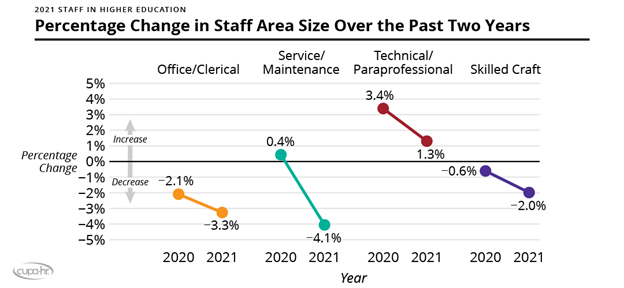Findings From CUPA-HR’s 2021 Staff in Higher Education Annual Report
The pandemic impacted every area of the higher ed workforce, including non-exempt employees. According to CUPA-HR’s recently released 2021 Staff in Higher Education Annual Report, the size of the non-exempt staff workforce saw a drastic decline during the pandemic, an understandable outcome given the number of non-exempt higher education employees whose work can only be performed on campus. Part-time non-exempt staff saw the greatest changes in workforce size, with a 17 percent decrease, compared to the prior academic year where the same group grew by 16.4 percent. Full-time non-exempt staff saw a significantly smaller (3.2 percent) decrease in size.
The staff area with the largest reduction over the past year was service/maintenance (-4.1 percent), followed by office/clerical (-3.3 percent) and skilled craft (-2.0 percent). Technical/paraprofessional employees experienced a 1.3 percent increase in size, but this increase was not as large as the increase the prior year (3.4 percent).

While it is too early to speculate as to whether staff job losses are permanent or temporary, next year’s data collection will reveal how many of these positions return when more on-campus operations resume.
Other Key Findings
- The overall median salary increase for staff from 2019-20 to 2020-21 was 0.75 percent, the lowest increase since 2014, when CUPA-HR started collecting data on non-exempt employees.
- Median salary increases were below 1 percent for all staff — office/clerical, service/maintenance, technical/paraprofessional, and skilled craft. Service/maintenance staff received the largest median increase, whereas skilled craft staff received the smallest median increase.
- The proportions of women and racial/ethnic minorities in the staff workforce are not much different from last year, indicating that cuts made during the past year did not disproportionately impact the representation of women and minorities in staff positions overall.
- Continuing trends from past years, women are less represented in service/maintenance and skilled craft positions. Women are paid less than men in all staff positions except office/clerical positions, where women are paid more than men. The pay gap between women and men is most pronounced in skilled craft staff.
- Minority men make up a little more than one-tenth of staff overall (13.3 percent). Minority women are better represented than minority men; they make up 20 percent of staff.
- Black and Hispanic/Latinx female staff are paid less than White male staff.
- If the minimum wage is raised to the proposed $15/hour, as of 2021, 23 percent of staff would require a salary adjustment. The largest salary adjustments would be required for service/maintenance staff, where 40 percent of these staff make below the proposed $15/hour. Looking across the country, the South would see the largest impacts, where 29 percent of staff would require salary adjustments.
To learn more about the Staff in Higher Education Annual Report, including key findings on representation and pay of the staff workforce, read the overview. Salaries, demographic comparisons and detailed trend information are available in the full report.
A total of 198,531 staff were reported for this year’s survey by 782 higher education institutions, covering 155 positions. This survey collects data at the incumbent level for all staff reported, allowing for the collection of salary, sex, race/ethnicity, age and years in position.


